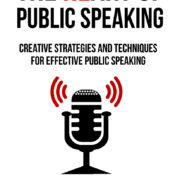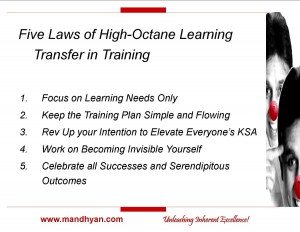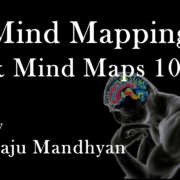Five Laws for High-Octane Learning Transfer in Training
All my life, I have enjoyed and applauded great teachers of all kinds and in all walks of life. I have spent thousands of hours watching,
listening, reading up and pondering about how is it that there are a few teachers/trainers who transfer so much knowledge and wisdom and also do it in a light and a non-intrusive way. I have a special affinity for such people and my life has been blessed by many such “gurus” of learning transfer.
Here are a handful of laws, I believe, they follow to become good at what they do and to churn up learning in individuals and organizations. Mind you these are not just the things they do but these are their guiding principles and they follow them, consciously and unconsciously, as if they were unwritten laws for High-Octane Learning Transfer.
- Focus on Learning Needs Only
- Many trainers and learning development specialists focus on what they can do well rather than what is needed on the job, by the learner and by the overall objectives of the enterprise. Stay away from what is “nice-to-know, easy-to-do” and focus only on what is needed to learn.
- Focus on real-time, real needs. Let lightness, entertainment and everything else be the packaging for the real learning.
- Keep the Training Plan Simple & Flowing
- Learning can occur through a structured flow or through lack of structure because “we are almost always learning.” What this means is that all 5 senses of the learner are constantly active and so is their ability to interpret, analyze and remember stuff. Our minds, no matter what, are constantly churning.
- Do include multiple modality shifts every so often. Use dialogue, exercises, inquiry, music, activities, humor, cross-pollinated questioning, visuals, videos etc., Do all this strategically and smoothly.
- Simplicity and Flow allow for new inputs by the learners and by the conversations that take place in the room, in the group space.
- Rev Up your Intention to Elevate Everyone’s KSA
- If you don’t walk into the classroom with an intense and an honest desire to create value for the learners in the room then what you will achieve will be mediocre and lukewarm. When you are committed to catalyze new learning, new discoveries and new results then your success rate automatically improves.
- Let your good intentions be followed by good self-discipline too. Come way ahead of time, be prepared, be courteous, polite and professional at all times. Give answers wherever needed and be honest about your own knowledge, skills and attitude.
- Work on Becoming Invisible
- More than a “trainer” like as in a gymnastics trainer, in the workplace atmosphere, you are a learning “facilitator” and that means you create the ambience and you are responsible for creating the ways and means for others to learn. Thus refrain from grand-standing, from being always right and from spoon-feeding the learners.
- When the group and the group dynamics are supporting the needed learning and the learning ambience then make efforts to step back, stay silent and applaud; become invisible. Your work is getting done by what you jump-started and is now snow-balling.
- Celebrate all Successful & Serendipitous Outcomes
- Master the ability to recognize all successes in new knowledge being understood, accepted and acted upon by learners. This is success and you must applaud it.
- Master the gentle alacrity to recognize that because of the new concepts and new challenges newer knowledge and attitude is generated. These are what are typically known as “aha!” moments in learning. Sharpen your senses to spot these serendipitous moments and applaud them too.
So let me share this story of two mother birds that I once heard. There was this one eager so excited at the thought of having a baby that she could not wait for her chick to hatch, She pecked the egg excessively and the little chick complied and popped out sooner than she should have. The mother bird was thrilled. However when she did grow up her wings were so weak that she was never able to fly without a boost from her mother. Then there was this second mother bird who so trusted in the paradigm that every chick must learn its own lessons and tackle life through its own efforts and expenses. When her little egg crackled a bit, she just stood by and watched. The baby chick struggled hopelessly to get out of its shell and in the struggle lost her life.
In essence, your participation as a learning facilitator has to be so balanced such that your pupils seemingly learn the right things, on the right time and learn such that they are empowered to fly on their own at work and in life.
Learning professionals will claim that there is a lot more needed to achieve excellence in transferring learning, nurturing a learning atmosphere in an organization and becoming a “guru” of learning but trust me, getting into the depths of these five laws and their many-sided applications will certainly boost up your abilities to become an excellent learning facilitator.
And, should you want to include creative thinking and creative structuring strategies in your training design and development may I recommend my book, The HeART of Public Speaking which employs the free-flowing technology of mind-mapping as a learning and training tool.









Leave a Reply
Want to join the discussion?Feel free to contribute!